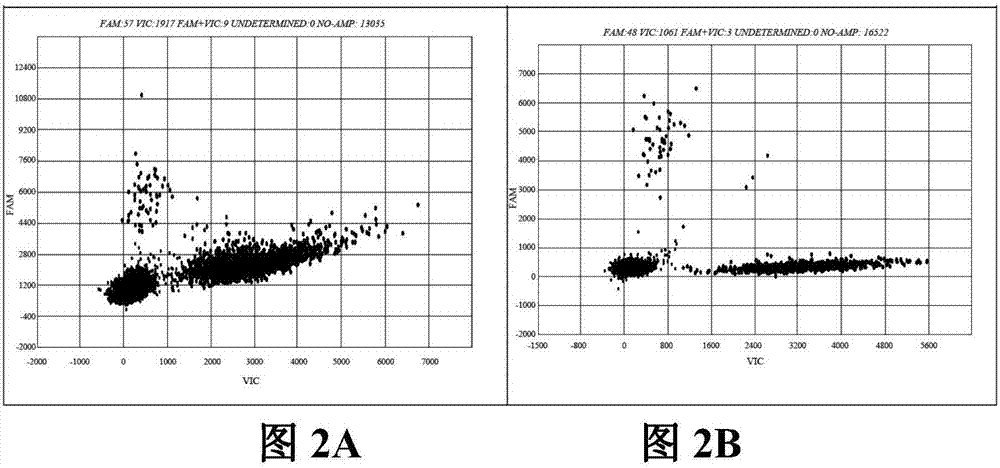Primer probe composition, kit and method for detecting KRAS and BRAF gene mutations through 3D (Three-dimensional) digital PCR (Polymerase Chain Reaction)
A technology of primer probes and kits, applied in the field of 3D-PCR detection, can solve the problems of low detection sensitivity and achieve high detection efficiency and intuitive and clear results
- Summary
- Abstract
- Description
- Claims
- Application Information
AI Technical Summary
Problems solved by technology
Method used
Image
Examples
Embodiment 1
[0091] Example 1: Detection of the effect of the primers and probes of the kit of this application
[0092] 1. Prepare the primer probe of the application kit
[0093] The primers and probes of KRAS and BRAF shown in Table 1 of this application are selected for use;
[0094] The primers and probes of other synthetic KRAS and BRAF are selected for comparison (referred to as comparison primers and probes), and the sequence information of other synthetic primers and probes is shown in Table 6:
[0095] Table 6:
[0096]
[0097]
[0098] 2. Amplification Reagent Preparation
[0099] Take out the corresponding PCR reaction solution from the kit, melt and mix at room temperature, centrifuge at 2000rpm for 10s, and prepare the PCR premix for each test according to Table 7 below. The preparation system is shown in Table 7 below:
[0100] Table 7:
[0101]
[0102] 3. Add sample
[0103] Load 14.5ul of the reaction system onto the digital PCR chip.
[0104] 4.PCR ampli...
Embodiment 2
[0113] Example 2: The minimum detection limit detection of the kit of this application
[0114] 1. Preparation of minimum detection limit quality control products
[0115] The DNA of KRAS gene G12A, G12C, G12D, G12S, G12V, G13D mutants was mixed with the KRAS-negative cell line genomic DNA in proportion to prepare the minimum quality control products for each mutant.
[0116] The DNA of the BRAF gene V600E mutant and the genomic DNA of the BRAF-negative cell line were mixed in proportion to prepare the minimum quality control product for the BRAF gene mutation.
[0117] A sample with a DNA template amount of 30ng and a mutation ratio of 0.2% was used as a detection limit quality control product in this embodiment. The minimum detection limit quality control products are specifically shown in Table 8:
[0118] Table 8:
[0119]
[0120] 2. The reaction system and operation steps are the same as in Example 1.
[0121] 3. The test was repeated 20 times, and the experimenta...
Embodiment 3
[0125] Example 3: Repeatability detection of the kit of the present application
[0126] 1. Preparation of duplicate quality control products
[0127] Select KRAS gene G12A, G12C, G12D, G12S, G12V, G13D mutant DNA and KRAS-negative cell line genomic DNA in proportion to prepare samples with a mutation ratio of 1% for each mutant, and select BRAF gene V600E mutation Somatic DNA and BRAF-negative cell line genomic DNA were mixed in proportion to prepare a sample with a mutation ratio of 1%, which was used as a repeated quality control product in this embodiment. Specifically as shown in Table 10:
[0128] Table 10:
[0129]
[0130] 2. Reaction system and operating steps are the same as in Example 1
[0131] 3. Repeat the test 10 times, and the experimental results obtained from the test are shown in Table 11-Table 17:
[0132] Table 11:
[0133]
[0134] It can be seen from the experimental results in Table 11 that the positive coincidence rate of the test results is...
PUM
 Login to View More
Login to View More Abstract
Description
Claims
Application Information
 Login to View More
Login to View More - R&D
- Intellectual Property
- Life Sciences
- Materials
- Tech Scout
- Unparalleled Data Quality
- Higher Quality Content
- 60% Fewer Hallucinations
Browse by: Latest US Patents, China's latest patents, Technical Efficacy Thesaurus, Application Domain, Technology Topic, Popular Technical Reports.
© 2025 PatSnap. All rights reserved.Legal|Privacy policy|Modern Slavery Act Transparency Statement|Sitemap|About US| Contact US: help@patsnap.com



